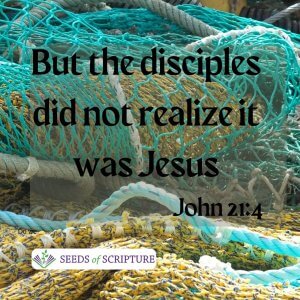Learn a Bible Study method: Journey into a Post-Resurrection Story in John 21
Topics to Dig Into
 Journey with me into today’s Bible story. As we read together, I’ll share a Bible study method that brings this post-resurrection appearance to life. Let’s venture into John 21.
Journey with me into today’s Bible story. As we read together, I’ll share a Bible study method that brings this post-resurrection appearance to life. Let’s venture into John 21.
A Miraculous Catch
Afterward Jesus appeared again to his disciples, by the Sea of Galilee. It happened this way: 2 Simon Peter, Thomas (also known as Didymus), Nathanael from Cana in Galilee, the sons of Zebedee, and two other disciples were together. 3 “I’m going out to fish,” Simon Peter told them, and they said, “We’ll go with you.” So they went out and got into the boat, but that night they caught nothing.
4 Early in the morning, Jesus stood on the shore, but the disciples did not realize that it was Jesus. Jn 21:1-4
 Set the scene – who, what, when, where:
Set the scene – who, what, when, where:
- The subheading hints at a miraculous catch, reminding me of a similar miracle. I search and read Luke 5:1-11. The fishing partners Peter, James and John (sons of Zebedee) broke their nets with a miraculous catch and Jesus called them to be disciples who fish for men. As this post-resurrection event unfolds, do they remember the first one?
- After what? John previously shares Jesus’ appearance to Thomas and the other disciples in Jerusalem. Evidently some time has passed; the disciples have returned to their fishing business in Capernaum on the Sea of Galilee where Jesus first called them.
- Peter decides to fish. Thomas, Nathanael, James and John join him.
- John tells the reader that Jesus appears (v1), but the disciples don’t have this information (v4).
5 [Jesus] called out to them, “Friends, haven’t you any fish?”
“No,” they answered.
6 He said, “Throw your net on the right side of the boat and you will find some.” When they did, they were unable to haul the net in because of the large number of fish.
My curiosity yields questions that guide my imagination and exploring (also called research):
- How does Jesus know they don’t have fish? Would the boat sit lower in the water if full? Would they be dragging nets? Is this divine knowledge?
- Why don’t they recognize Jesus? They see a physical person and hear his voice. Are they too far from shore to see his face and scars? Is Jesus unrecognizable as he was to the women and the disciples traveling to Emmaus?
- Did Jesus commonly greet his group of disciples as ‘friends’? Are there comparison scriptures?
- Is there significance to right vs. left?
- Why, after a fruitless night of fishing, do the sweaty, exhausted fishermen follow the instructions of a stranger without objection as in Luke 5:5?
7 Then the disciple whom Jesus loved said to Peter, “It is the Lord!” As soon as Simon Peter heard him say, “It is the Lord,” he wrapped his outer garment around him (for he had taken it off) and jumped into the water. 8 The other disciples followed in the boat, towing the net full of fish, for they were not far from shore, about a hundred yards.
- What triggers John (the disciple whom Jesus loved) to recognize Jesus? Has he looked more closely? Is it the miracle?
- Peter’s impulsive splash fits his character. Why get dressed first? My Bible’s footnote says it would be improper to greet someone in an undergarment. That makes sense!
- Peter slogs through water fully clothed the length of a football field! Impressive! So remarkable that I checked the footnote. Yards is actually cubits, the average length from elbow to fingertip, 18 inches. Peter only slogs ½ a football field – still quite a distance in traditional clothing of the day.
9 When they landed, they saw a fire of burning coals there with fish on it, and some bread.
10 Jesus said to them, “Bring some of the fish you have just caught.” 11 So Simon Peter climbed back into the boat and dragged the net ashore. It was full of large fish, 153, but even with so many the net was not torn.
- Jesus already has cooked fish. Why does he request fish from the fresh catch? Is their participation significant?
- Peter can’t possibly drag the net ashore alone. He apparently leads or speeds the effort.
- Large fish were taxed, hence counted. The net also caught smaller fish. Did they throw them back?
- What does the fish count indicate? Are there other fish counts for comparison?
Is it significant that the net doesn’t break as it does in Luke.
12 Jesus said to them, “Come and have breakfast.” None of the disciples dared ask him, “Who are you?” They knew it was the Lord. 13 Jesus came, took the bread and gave it to them, and did the same with the fish. 14 This was now the third time Jesus appeared to his disciples after he was raised from the dead.
- Jesus invites them to his ‘table’. He “took the bread and gave it to them” feels familiar. Is the blessing implied? Do they recognize Jesus in the breaking of the bread as in the Emmaus story?
- Why do they still have the urge to ask “Who are you?” if they know it’s the Lord? Why their uncertainty?
- I stumble on the idea that they ‘know’ it’s the Lord, but don’t ‘dare to ask’ or ‘venture’ (in other translations). It feels like they want verification. Are they embarrassed to expose their uncertainty?
- What does ‘know’ mean if they’re still uncertain? I wandered into Strong’s Concordance for the words dare and know for insight.
- In his previous two post-resurrection appearances Jesus showed them his scars (Jn 20). Does he have a different physical body this time?
Those are my observations and questions. What do you see? What do you ask of the scripture?
I see several paths to explore – the parallel miraculous catches pre-discipleship and post-resurrection, the problem of recognizing Jesus, the meal, or knowing the Lord while still desiring confirmation.
Your turn:
- Journey along one of these paths.
- Explore your study Bible notes.
- Compare Bible translations for insights.
- For a challenge, wander into Strong’s Concordance for original word meanings.
Please share your questions and discoveries in the comments! I would love to hear about your adventure!
I have long encouraged readers to dig beneath the surface because every word choice matters.
#SeedsofScripture #biblelesson #scripturestudy #biblestudymethod #readthebiblebetter #redletterwords #miraclestory #seeJesus

Interesting Ms. Cathy. Question-based study is always good as it leads us to investigate where we are led. I too enjoy this method, but I try to start with a prayer that asks the Holy Spirit to open my eyes and lead me to discover what He wants me to see, understand, and learn. Then, guide me in how to apply to my life and/or others. Like you, I keep expositions, dictionaries, and a Concordance at the ready. Always enjoy ma’am. Thank you!
Prayer is absolutely the best place to start. I definitely should have mentioned the guidance of the Spirit. Thank you for that reminder.